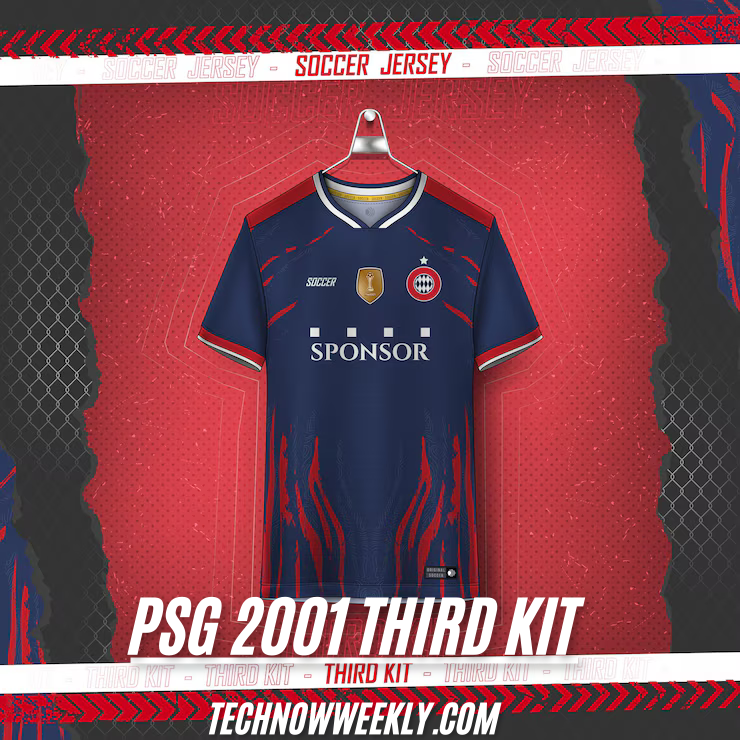In the world of football, team kits transcend mere clothing; they embody a team’s identity, history, and connection with fans. One of the most intriguing pieces of football memorabilia is the PSG 2001 third kit, a standout in Paris Saint-Germain’s storied wardrobe. This article delves into the full details of the PSG 2001 third kit, exploring its design, significance, and enduring legacy in the world of football fashion.
A Bold Design Statement
The PSG 2001 third kit was a striking departure from traditional football aesthetics of the time. It featured a vibrant orange color scheme that was a daring choice compared to the club’s more familiar blue and red palette. This bold design decision made the kit instantly recognizable and a favorite among fans who appreciated its audacious style.
The jersey was crafted with minimalist accents, including a navy-blue collar and trim, which provided a subtle contrast to the dominating orange hue. The front of the jersey prominently displayed the logo of the club’s then-sponsor, Opel, in a crisp white font, complementing the bright background. The PSG crest was positioned on the left chest, a proud emblem of the club’s heritage.
The Kit’s Technical Features
Beyond its aesthetic appeal, the PSG 2001 third kit incorporated several technical innovations that reflected the evolving trends in football apparel. Manufactured by Nike, the kit utilized lightweight, breathable fabric designed to enhance player performance. The material featured Dri-FIT technology, which helped wick away sweat and keep players comfortable during high-intensity matches.
The jersey’s fit was tailored to provide freedom of movement while maintaining a sleek silhouette. Mesh panels on the sides ensured optimal ventilation, a feature particularly beneficial for games played in warmer climates. The attention to detail extended to the shorts and socks, which echoed the jersey’s orange and navy-blue color scheme, creating a cohesive and visually appealing ensemble.
Historical Context and Matches
The 2001 season was a transitional period for Paris Saint-Germain. While the club was striving to assert its dominance in both domestic and European competitions, the third kit became a symbol of their ambition. The kit was primarily used in European fixtures and select domestic matches, giving it an exclusive aura.
One of the most memorable appearances of the PSG 2001 third kit was during the UEFA Cup matches. The team’s performance, coupled with the kit’s striking design, left a lasting impression on fans and opponents alike. Though the season didn’t culminate in major silverware, the kit’s role in defining the team’s identity during this era cannot be understated.
Fan Reception and Legacy
When the PSG 2001 third kit was unveiled, it received mixed reactions. Traditionalists were initially skeptical of the departure from the club’s iconic colors, but younger fans and fashion-forward supporters embraced the bold design. Over time, the kit’s unique aesthetic and association with a pivotal era in PSG’s history endeared it to a broader audience.
Today, the PSG 2001 third kit is regarded as a collector’s item. Retro football enthusiasts and PSG supporters alike seek out this jersey for its nostalgic value and standout design. Its rarity has made it a prized possession in the world of football memorabilia, often fetching high prices in auctions and online marketplaces.
Influence on Modern Football Kits
The influence of the PSG 2001 third kit extends beyond its era. It set a precedent for experimentation with bold colors and unconventional designs in football kits. In the years that followed, Paris Saint-Germain and other clubs adopted more adventurous approaches to their third kits, often using them as a platform for creative expression.
In recent times, PSG has become synonymous with fashion-forward football kits, collaborating with high-profile brands like Jordan and embracing streetwear aesthetics. The 2001 third kit can be seen as a precursor to this trend, showcasing the club’s willingness to break away from tradition and embrace innovation.
Keep reading: refrig-o-pak model
Collecting the PSG 2001 Third Kit
For collectors and fans looking to own a piece of football history, acquiring the PSG 2001 third kit can be both a rewarding and challenging endeavor. Authentic versions of the kit are scarce, and their value has appreciated significantly over the years. Key factors to consider when purchasing this jersey include:
- Condition: Kits in mint condition, with no damage or fading, are the most sought after.
- Authenticity: Look for official Nike tags and the club crest to ensure the jersey is genuine.
- Provenance: Jerseys worn by players or associated with specific matches hold additional value.
Specialist retailers, online marketplaces, and dedicated football memorabilia shops are the best places to find this iconic kit. However, potential buyers should exercise caution and verify the authenticity of the jersey before making a purchase.
PSG 2001 Third Kit in Popular Culture
The distinctiveness of the PSG 2001 third kit has cemented its place in popular culture. It has been referenced in fashion circles as an example of early 2000s sportswear trends and continues to inspire modern designs. Fans have also showcased the kit in exhibitions, social media posts, and retro-themed events, celebrating its lasting appeal.
Conclusion
The PSG 2001 third kit is more than just a football jersey; it is a symbol of creativity, ambition, and the evolving relationship between sports and fashion. Its bold design, technical innovations, and historical significance have secured its place as a standout in Paris Saint-Germain’s legacy. For fans and collectors, the kit represents a unique chapter in the club’s history, one that continues to inspire admiration and nostalgia.
As football kits evolve, the PSG 2001 third kit remains a reminder of the power of bold design and the timeless appeal of embracing the unconventional. Whether displayed in a collector’s showcase or worn proudly by a fan, this kit exemplifies the magic of football fashion at its finest.










